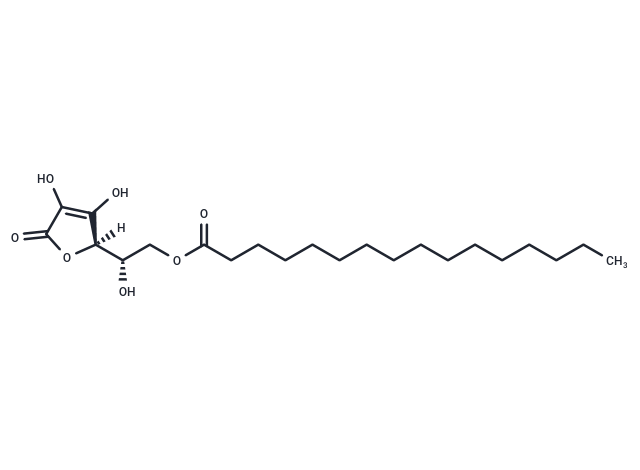Shopping Cart
- Remove All
 Your shopping cart is currently empty
Your shopping cart is currently empty

Ascorbyl palmitate (L-Ascorbic acid 6-hexadecanoate), an ester formed from ascorbic acid and palmitic acid, produces a fat-soluble form of vitamin C.

| Pack Size | Price | Availability | Quantity |
|---|---|---|---|
| 50 mg | $30 | In Stock | |
| 100 mg | $42 | In Stock | |
| 200 mg | $58 | In Stock | |
| 500 mg | $74 | In Stock | |
| 1 mL x 10 mM (in DMSO) | $46 | In Stock |
| Description | Ascorbyl palmitate (L-Ascorbic acid 6-hexadecanoate), an ester formed from ascorbic acid and palmitic acid, produces a fat-soluble form of vitamin C. |
| In vitro | L-Ascorbyl 6-palmitate is a synthetic lipophilic ascorbic acid derivative. L-Ascorbyl 6-palmitate is an effective preservative in foods and an effective dietary antitumor promoter in mice. Studies indicate that dietary L-Ascorbyl 6-palmitate is a source of tissue vitamin C in animals. Besides, dietary L-Ascorbyl 6-palmitate possesses weak antiscorbutic activity in guinea pigs and enhances vitamin C nutriture in humans. [1] |
| Alias | L-Ascorbyl 6-palmitate, L-Ascorbic acid 6-hexadecanoate, 6-O-Palmitoyl-L-ascorbic acid |
| Molecular Weight | 414.53 |
| Formula | C22H38O7 |
| Cas No. | 137-66-6 |
| Smiles | [C@@H](COC(CCCCCCCCCCCCCCC)=O)(O)[C@]1(OC(=O)C(O)=C1O)[H] |
| Relative Density. | 1.15 g/cm3 |
| Storage | Powder: -20°C for 3 years | In solvent: -80°C for 1 year | Shipping with blue ice. | |||||||||||||||||||||||||||||||||||
| Solubility Information | Ethanol: 77 mg/mL (185.75 mM), Sonication is recommended. H2O: < 1 mg/mL (insoluble or slightly soluble) DMSO: 60 mg/mL (144.74 mM), Sonication is recommended. | |||||||||||||||||||||||||||||||||||
Solution Preparation Table | ||||||||||||||||||||||||||||||||||||
DMSO/Ethanol
| ||||||||||||||||||||||||||||||||||||

Copyright © 2015-2025 TargetMol Chemicals Inc. All Rights Reserved.